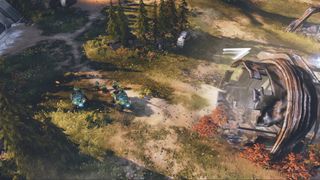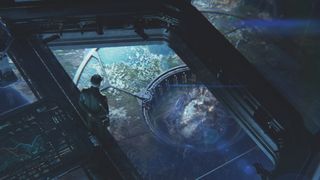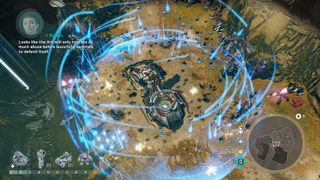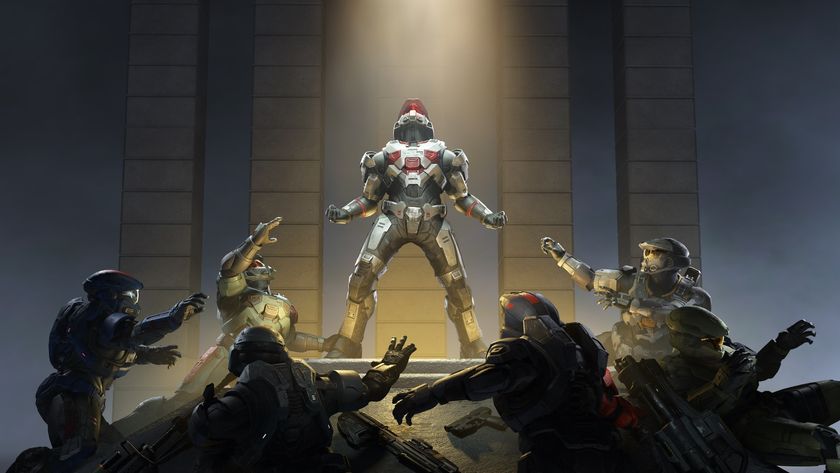Doing for interplanetary relations what Duke Nukem did for the peace process. It’s Halo Wars 2 online

If my family ever decides to cheap out on my epitaph – and recent Christmas gifts suggest they probably will – then the words ‘sci-fi’ and ‘massive battles’ should just about sum me up. Hell, I don’t even need a D.O.B, or a headstone. Just scratch that stuff into the mud somewhere and I’ll happily call it quits. All of which is to say that The Creative Assembly’s latest game is a title right up my alley.
When I reviewed it, I gave the new Halo Wars 2 a commendable 8/10 because of slick controls, satisfying combat and a focused, pared-down presentation. This month I’ve been turning my attentions to the game’s multiplayer contingent and to the terrifying results therein...
Now, when I say ‘terrifying results’, what I actually mean is defeat – lots and lots of defeat. You see, where the main campaign gives you the breathing room to hotkey your units and pick apart your enemies, multiplayer matchups make for an altogether different beast. Here, my natural proclivity for turtling and micromanagement may as well be an albatross hanging around my neck, an albatross that keeps crapping down my trousers and screeching in my ear.

I eventually relent and switch tactics, reasoning that a bit of unit queuing, and the occasional missed battle is worth the smug sense of satisfaction that comes with besting my enemies. “Crikey,” I say to myself, “I may as well be playing me from a half hour ago, that total bloody idiot”.
Of course, it’s no secret that console fans are less acquainted with the tactical flourishes required of real- time strategy titles, and yet the level of play is still quite low here. Many a round of 1v1 Deathmatch comes and goes before even a single enemy thinks to nab a power node. Like Company Of Heroes or Dawn Of War, everything depends upon holding these particular resource pools, and mounting a daring early raid will oftentimes prove decisive.
The same generally holds true of Strongholds mode, which encourages players to duke it out over a limited number of build sites. The more you own, the greater your pop cap becomes and the more articles of tech that you and your team can construct. Whichever team holds the most ground at the end of time is declared the winner, though outright annihilation is also a possibility.

With infinite resources to hand, Strongholds is the go-to mode for anyone looking for a hectic, action-packed experience. It’s just a shame then that the game so often conspires to keep your eyes away from the action. You can’t view an overarching build queue here, or line up any replacement units once the pop cap has been reached.
Sign up to the 12DOVE Newsletter
Weekly digests, tales from the communities you love, and more
In addition, marshalling new forces proves next to impossible while taking personal command of the action. In fact, the only means to do so lies in routinely jumping between home base and the battlefield, a staple of the genre to be sure, but one that doesn’t make missing out on these epic confrontations any easier. One moment you’ll be Genghis Khan, preparing to lead a mighty charge, and the next hammering out requisition orders like a belligerent office clerk.
Next up is Domination – similar in scope to Deathmatch, but with the added caveat that players must hold onto various control towers in order to increase their score – with the first team to hit the designated total winning the game. Power nodes also come into play here, creating an interesting risk/benefit to every potential power grab. Do you chase down nodes for additional resources and more troops, or hunker down on the control zones to bolster your score? Decisions, decisions...

Fourth and arguably foremost is the game’s new Blitz mode, a quick-fire match type that’s best described as a fast-paced riff on Domination. Oh yes, and there are some cards to collect, and sort out into decks and play haphazardly in the heat of the moment and, oh god, why didn’t I just wait for the giant Scarab tank instead of these Teflon-coated kittens...?
Difficult decisions like these are the real crux of the Blitz experience, which sees Domination’s power nodes exchanged for occasional resource drops. These drops must first be contested and then collected in order to increase your turnover, with fast-acting players likely to receive as many as twice the power points per second as their more ponderous rivals.
Stripped of a starting base, players are instead offered a choice of four random cards from their deck of 20. Playing one card will see it immediately replaced by another, with the entire pack continually recycling. These cards take the form of units, turrets and status effects, with better cards costing more power to play.

It’s a system that encourages both progression and rabid collection, while also maintaining a reasonable degree of fairness. The trouble is that better decks do often trump player skill – a situation that’s not helped by some sketchy overall matchmaking. In my experience, only half of the games played were against similarly levelled players – and the same can generally be said of the entire multiplayer suite. One particularly daunting matchup involved a player with more than three times my experience.
Taking the early lead here was like pottering around in that abandoned fort from Starship Troopers. I suspected a trap all right. What I actually got was the most one-sided beatdown since Casper Van Dien took on Shakespeare In The Park [citation needed].
And speaking of folks having their brains sucked out, Halo Wars 2 really does live and die depending on the skills of your teammates. Restrictive matchmaking means anyone without a party of friends is instead forced to seek their fortune among the great unwashed of the internet. With the exception of offline skirmishes and the 1v1 ‘Solo War’, most of your time with Halo Wars 2 will be spent among random allies. Hell, even the option to take on the computer together is marred by the inability to select a difficulty setting or game type. It’s a classic case of ‘you’ll get what you’re given’, and it’s sure to prove mightily imposing for newbies.

Of course, veteran RTS players are likely to be just as aggravated, with a virtuoso solo performance not typically enough to make up for shoddy allied play. One game of Strongholds saw me holding onto three bases simultaneously, but with my allies faltering on the flanks we soon went down to defeat. Picture the bit in Earth Song where Michael Jackson holds onto those two trees while screaming at the wind, and you’ll have some idea how I felt. It’s troubling to think just how long it may take to raise your level to the point where this is no longer an issue.
On the flip side, matching up with a quality player or two can transform the experience. Working together towards a common goal, usually with no more than an occasional ping to point out areas of interest, often feels fantastic. Coordinating strikes, splitting duties in Blitz or relieving an embattled chum at the last moment all provide giddy thrills that work to fulfil much of the game’s promise.
To be clear, this is a game best played with friends, or failing that, some of the more capable folks you’ll meet online. All told, Halo Wars 2 online has the potential to become a successful, vibrant addition to the Halo franchise. Whether you want to analyse build orders, commander picks and card hands is up to you, of course. Just don’t expect to have the best time doing so alone.
This article originally appeared in Xbox: The Official Magazine. For more great Xbox coverage, you can subscribe here.

















